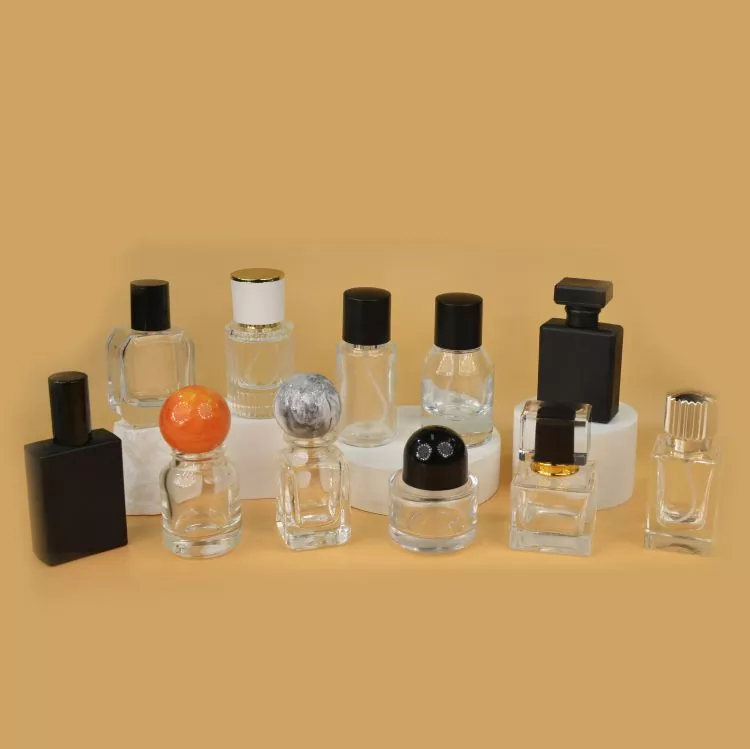What's Materials Used in Perfume Bottles?
2024-06-14
Perfume bottles are crafted from a variety of materials to achieve the desired aesthetic, functionality, and durability. Here are the main materials commonly used in perfume bottles:
1. Glass
- Description: The most prevalent material for perfume bottles.
- Types:
- Clear Glass: Allows the perfume's color to be visible.
- Colored Glass: Provides UV protection and adds to the visual appeal.
- Frosted Glass: Offers a sophisticated, opaque look.
- Advantages:
- Impermeable and non-reactive, preserving the perfume's integrity.
- Can be molded into various shapes and sizes.
- Easily customizable with etching, embossing, or painting.

2. Plastic
- Description: Used for more affordable or travel-sized perfume bottles.
- Types:
- PET (Polyethylene Terephthalate): Lightweight, durable, and resistant to shattering.
- Acrylic: Offers a glass-like appearance with the durability of plastic.
- Advantages:
- Lightweight and shatterproof.
- Cost-effective for mass production.
- Flexible in design and color options.
3. Metal
- Description: Often used for decorative elements or outer casings.
- Types:
- Aluminum: Lightweight and corrosion-resistant.
- Stainless Steel: Durable and provides a sleek, modern look.
- Gold or Silver Plating: Adds a luxurious touch.
- Advantages:
- Provides structural integrity and durability.
- Enhances the aesthetic appeal with a premium feel.
- Often used in combination with other materials (e.g., glass bottles with metal caps).
4. Crystal
- Description: A high-end material used for luxury perfume bottles.
- Types:
- Lead Crystal: Known for its brilliance and clarity.
- Non-Lead Crystal: An eco-friendlier option with similar visual properties.
- Advantages:
- Exceptional clarity and refractive qualities.
- Adds a luxurious, high-end appeal.
- Can be intricately cut and polished for a stunning finish.
5. Ceramic
- Description: Less common but used for unique or artisanal perfume bottles.
- Types:
- Porcelain: Fine, high-quality ceramic.
- Stoneware: More robust and durable than porcelain.
- Advantages:
- Can be handcrafted for unique designs.
- Provides a distinctive, tactile feel.
- Can be glazed or painted for various artistic effects.
6. Wood
- Description: Used mainly for caps or decorative elements.
- Types:
- Hardwoods: Such as oak, walnut, or mahogany.
- Softwoods: Such as pine, used less frequently due to durability concerns.
- Advantages:
- Adds a natural, rustic touch.
- Can be carved, stained, or treated for different finishes.
- Lightweight and environmentally friendly.
Additional Considerations:
- Decorative Elements:
- Lacquer and Paint: Used to add color and protective coatings.
- Labels and Inscriptions: Often made of paper, metal, or plastic.
- Embellishments: Such as gemstones, ribbons, or fabric accents to enhance visual appeal.
- Functional Components:
- Spray Nozzle and Pump: Usually made of plastic or metal, critical for dispensing the perfume.
- Cap: Can be made from metal, plastic, wood, or combinations, designed to fit securely and protect the nozzle.
Summary:
Perfume bottles are crafted from a variety of materials including glass, plastic, metal, crystal, ceramic, and wood. Each material offers distinct advantages in terms of aesthetics, durability, and cost. The choice of material often reflects the brand's image, target market, and functional requirements of the perfume packaging.


